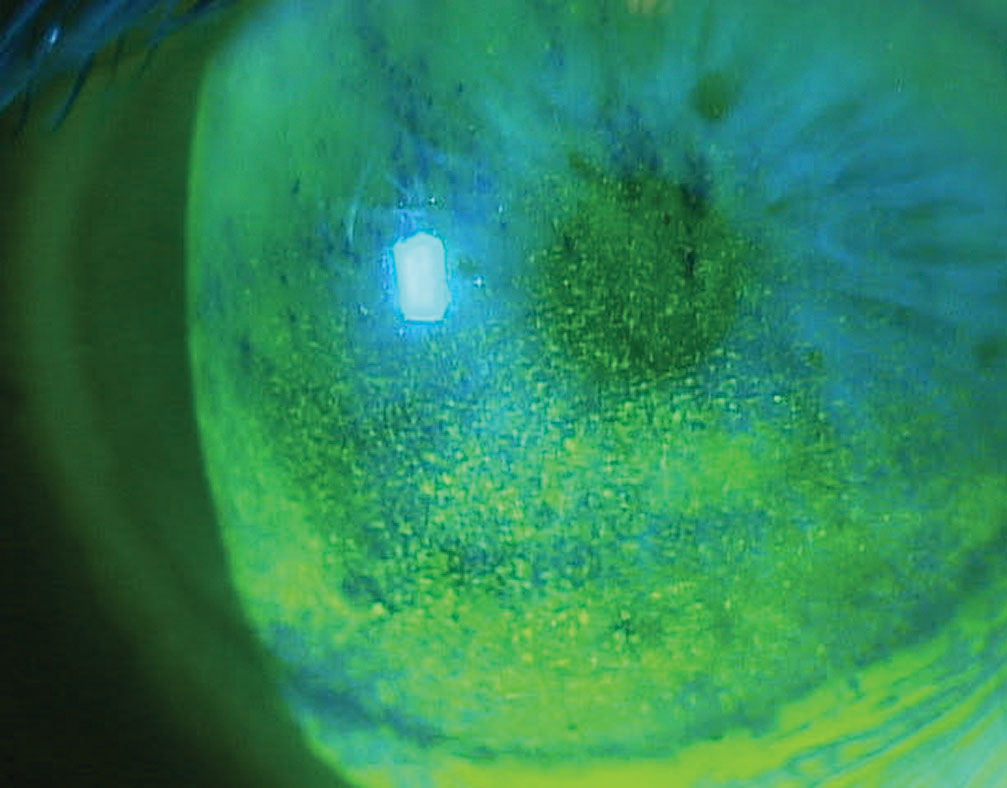 |
| Preservatives, phosphate content, pH and viscosity of glaucoma eye drops can have an adverse effect on the ocular surface in these patients. Photo: Paul Karpecki, OD. Click image to enlarge. |
Nonadherence in glaucoma can arise from many factors, of which significant ocular surface side effects from preserved products often figure prominently, highlighting the importance of patient education on disease treatment. A meeting of glaucoma and ocular surface experts organized by the Tear Film and Ocular Surface Society addressed this phenomenon. The group recently published their findings in The Ocular Surface, documenting the various challenges glaucoma patients face, with a special focus on how to improve adherence and surgical outcome and whether ocular adverse effects are minimized when treatment is initiated and adhered to.
Many of the challenges that patients with glaucoma experience can be reduced by raising awareness of the drawbacks of treatment, one of them being the use of preservatives in eye drops and the associated unnecessary side effects. This practice should be reduced or avoided altogether, according to the experts.
The TFOS paper cites a study in four European countries including more than 9,500 glaucoma patients using preserved or preservative-free eye drops showed the impact of topical glaucoma medications on the ocular surface. Each recorded symptom was significantly more frequent in the preservative group compared with the preservative-free group.
“The symptom “Dry Eye Sensation,” for example, was present in 34.9% of patients with preserved glaucoma medication vs. 16% in patients with preservative-free medication,” the team wrote in their paper. “Each recorded sign (e.g., eczema, anterior/posterior blepharitis, conjunctival hyperemia, follicles and staining) was also significantly more frequent in the preservative group compared with the preservative-free.”
Another study cited by the expert panel analyzed 101 patients with primary open-angle glaucoma or ocular hypertension on anti-glaucoma medication and showed that many suffered from dry eye symptoms, had a reduced Schirmer test, exhibited ocular surface staining and demonstrated a reduced tear film breakup time.
The study reported that patients who were treated with latanoprost and tafluprost showed increased ocular surface staining and meibomian gland dropout and a decreased expressibility and quality of meibum. Another prospective study examining the same prostaglandin analogs found no evidence of increased meibomian gland dropout compared with baseline during 12 months of follow-up.
“Moreover, tafluprost and timolol did not cause any discernible clinical or microscopic changes measured with in vivo confocal microscopy compared with healthy controls,” the authors explained. “However, patients treated with bimatoprost/timolol fixed combination demonstrated worse scores concerning signs and symptoms of dry eye disease, goblet cell density and meibomian gland parameters measured with in vivo confocal microscopy compared with healthy controls.”
“Another challenge is the use of generic eye drops that come with different packaging, different solvents and not least different preservatives,” the paper goes on to say. “For those patients who must undergo glaucoma surgery, there is a greater risk of an unsuccessful result if the conjunctiva is affected due to adverse effects from many years of eye drop use.”
When managing ocular surface disease in glaucoma, there are four steps that should be taken, according to the expert panel:
1) Evaluate patients for ocular surface disease prior to treatment initiation.
2) Re-evaluate patients regularly for ocular surface disease during the course of treatment.
3) In the case of significant ocular surface disease interfering with glaucoma outcomes, identify allergy vs. dry eye and inflammation vs. irritation, as well as consider switching to other compounds when available.
4) If glaucoma surgery is required, either for eyedrop intolerance or insufficient intraocular pressure control, consider prescribing anti-inflammatory eye drops before surgery.
“All in all, it is important to see the patient as a whole person and to find the treatment with the least possible side effects, which is also understandable for the patient,” the authors explained. “In addition, it is important that the text on the packaging is clear so that patients can read what they are putting in their eyes.
The authors concluded that eye drops against glaucoma cause many adverse effects on the ocular surface and adnexae, increasing the risk of nonadherence and a poor outcome.
“Communication about the importance of the treatment is crucial for patients to continue the treatment despite the side effects,” the authors explained in this study. “Although it is well known that preservatives cause side effects and should be minimized, it is important to know that the active substance and other factors such as phosphate content, pH and viscosity of the eye drops can have an adverse effect on the ocular surface.”
Kolko M, Gazzard G, Baudouin C, et al. Impact of glaucoma medications on the ocular surface and how ocular surface disease can influence glaucoma treatment. Ocul Surf. June 9, 2023. [Epub ahead of print]. |

